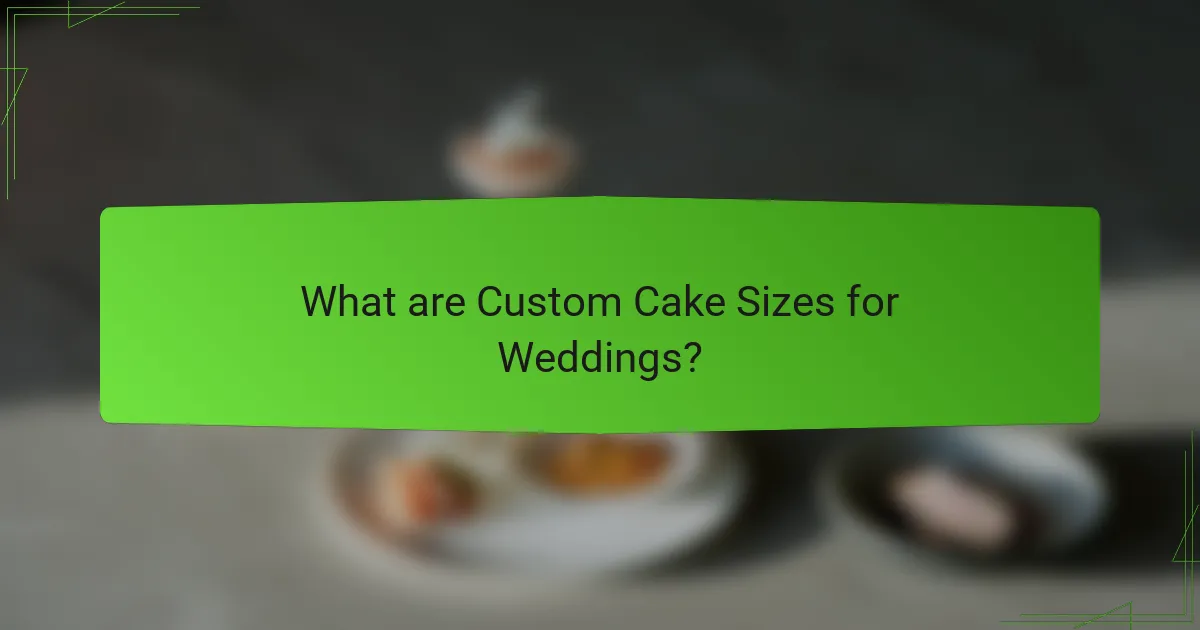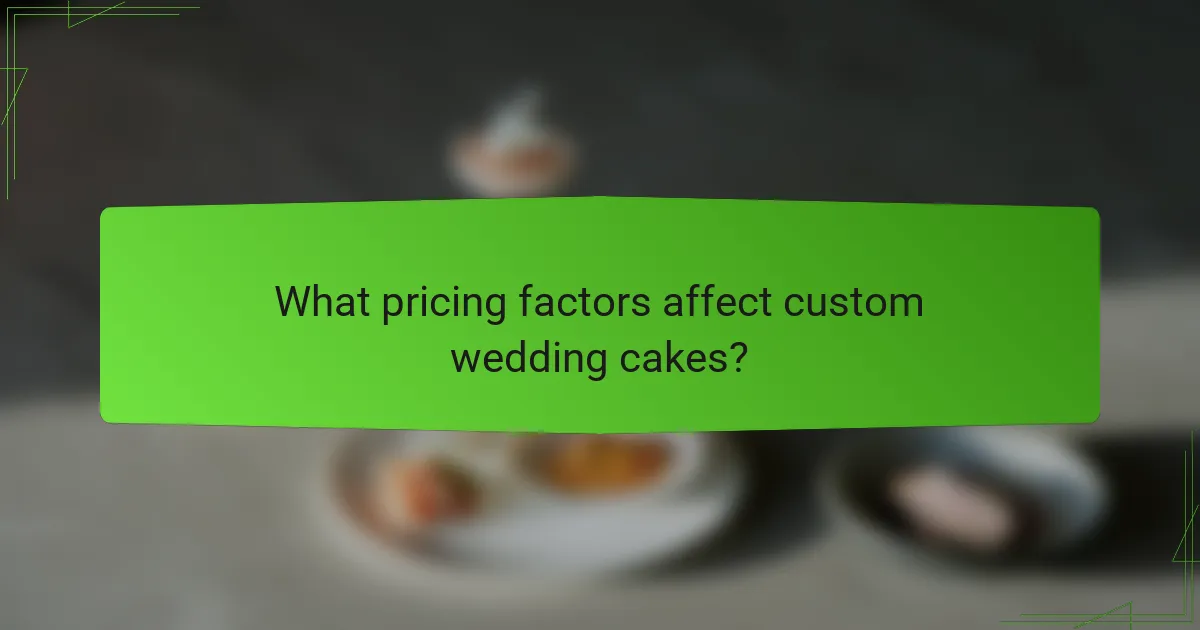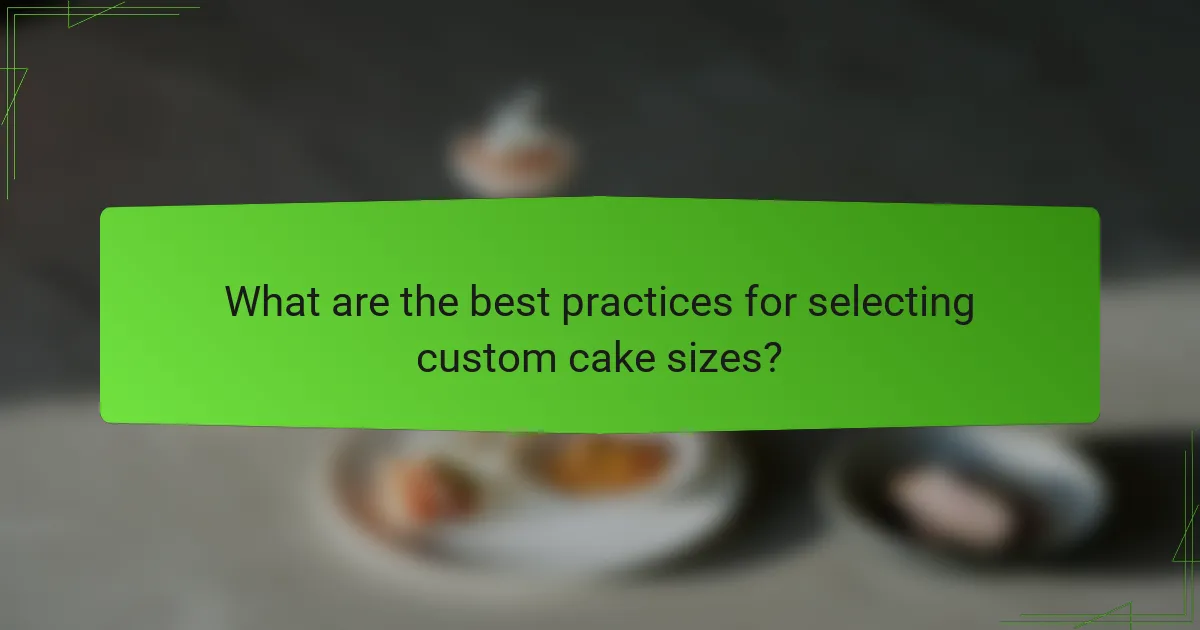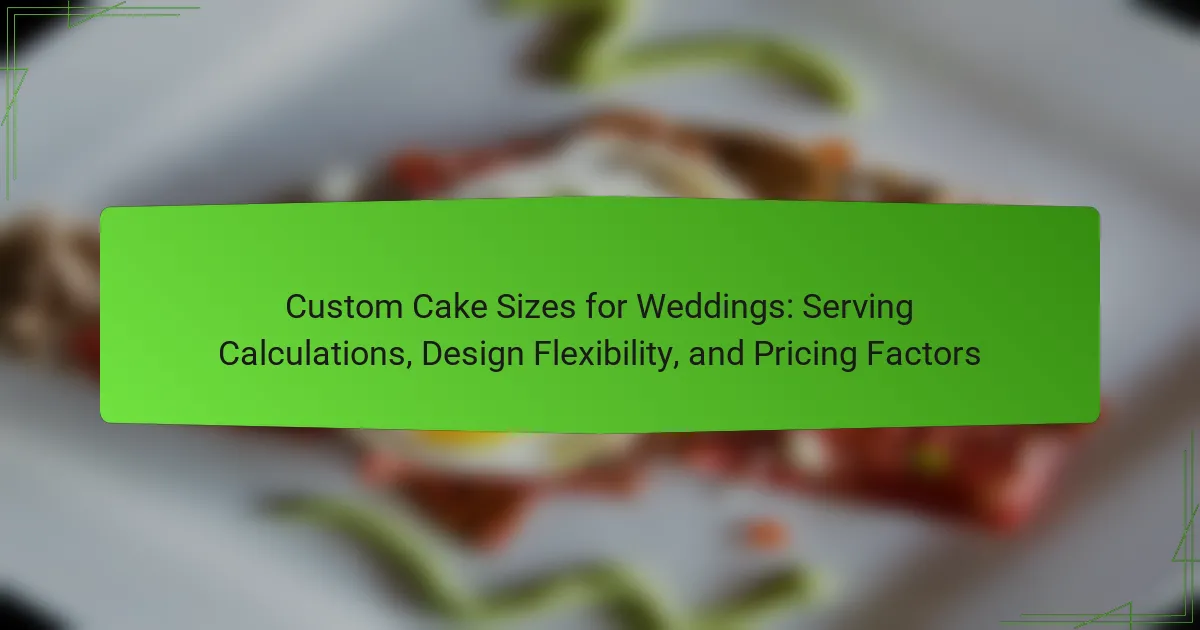
What are Custom Cake Sizes for Weddings?
Custom cake sizes for weddings refer to the tailored dimensions of wedding cakes designed to meet specific guest counts and aesthetic preferences. These sizes can vary widely based on the number of servings needed. Common sizes include 6-inch, 8-inch, and 10-inch rounds, often stacked to create multi-tiered designs. A standard serving size for wedding cake is approximately 1 inch by 2 inches. For example, a 6-inch cake typically serves about 12 people, while an 8-inch cake can serve around 20. Custom sizes allow for unique designs and accommodate dietary preferences. Bakeries often provide consultations to determine the ideal size based on guest count and design requirements.
How do custom cake sizes impact wedding planning?
Custom cake sizes significantly impact wedding planning by influencing guest servings, design choices, and budget considerations. When determining cake size, planners must consider the number of guests to ensure everyone is served. For instance, a standard serving size is typically one slice per guest. Custom sizes allow for unique designs that align with the wedding theme. Larger cakes can accommodate intricate designs, while smaller cakes may limit creativity. Additionally, custom sizes affect pricing; larger cakes generally cost more due to ingredients and labor. Therefore, the chosen cake size directly influences the overall wedding budget and design flexibility.
What factors should be considered when choosing a cake size?
When choosing a cake size, several factors must be considered. The number of guests is the primary factor. A larger guest list requires a bigger cake to ensure everyone is served. The occasion also influences the size; weddings typically need larger cakes than smaller celebrations. The cake’s design and tiers affect its size as well. More tiers often mean a larger cake. Budget constraints play a crucial role; larger cakes generally cost more. Lastly, the type of cake and serving style can impact size; some cakes are denser and may require less volume to serve the same number of guests.
How do guest count and cake size relate?
Guest count directly influences cake size. A larger number of guests requires a bigger cake to ensure everyone is served. Typically, one standard slice of cake serves one person. Therefore, if there are 100 guests, a cake must be sized to provide at least 100 slices. Cake sizing charts often suggest specific dimensions based on the number of servings needed. For example, a 6-inch cake serves about 12 people, while an 8-inch cake serves about 24. Accurate calculations ensure that there is enough cake for all attendees. This relationship is crucial for event planning to avoid running out of cake.
Why is serving calculation important for wedding cakes?
Serving calculation is important for wedding cakes to ensure that there is enough cake for all guests. Accurate serving calculations help determine the cake size needed based on the number of attendees. This prevents running out of cake, which can lead to disappointment. Additionally, it helps in managing costs effectively. A cake that is too large can result in unnecessary expenses. Conversely, a cake that is too small can lead to wastage or insufficient servings. Proper calculations also allow for creative designs while maintaining functionality. Overall, serving calculations are essential for a successful wedding cake experience.
How can you calculate the number of servings needed?
To calculate the number of servings needed for a custom wedding cake, determine the number of guests first. Each guest typically requires one slice of cake. The serving size can vary based on the cake type and design. Standard serving sizes range from 1 to 2 inches for a wedding cake. For example, a 6-inch round cake serves about 12 people, while an 8-inch round cake serves about 20. Multiply the number of guests by the serving size to find the total servings required. This calculation ensures that there is enough cake for everyone.
What are standard serving sizes for different cake types?
Standard serving sizes for different cake types generally vary. For a round cake, a standard serving is typically 1 slice of 1 inch by 2 inches. This yields about 12 servings for an 8-inch cake. A 10-inch round cake usually serves around 20 people. For sheet cakes, a 1-inch by 2-inch slice provides approximately 24 servings for a quarter sheet and 48 servings for a half sheet. For tiered cakes, a standard serving is also 1 inch by 2 inches per slice. Therefore, a 6-inch tier serves about 10, while an 8-inch tier serves about 20. These serving sizes are commonly accepted in the baking industry.
What design flexibility do custom cake sizes offer?
Custom cake sizes offer significant design flexibility for weddings. They allow for tailored dimensions that fit specific themes or venue spaces. Bakers can create multi-tiered designs that enhance visual appeal. Custom sizes enable the incorporation of unique shapes, such as hexagons or hearts. This flexibility supports personalized designs that reflect the couple’s style. Additionally, custom sizes help in managing serving portions effectively. This ensures that the cake meets the guest count without excess waste. Overall, custom cake sizes enhance creativity and personalization in wedding cake design.
How can custom sizes accommodate unique wedding themes?
Custom sizes can accommodate unique wedding themes by allowing for tailored designs that reflect specific aesthetics. Cakes in custom sizes can match the scale of the wedding venue, enhancing visual impact. This flexibility enables couples to incorporate unique shapes and structures that align with their theme. For example, a rustic wedding may benefit from a tiered cake with natural elements. Custom sizes also facilitate serving calculations, ensuring every guest is catered to. According to a study by the American Cake Decorators Association, tailored cakes increase satisfaction among guests by 30%. This ensures that the cake not only looks good but also complements the overall wedding experience.
What design elements are influenced by cake size?
Cake size influences several design elements including tier height, decoration quantity, and serving style. Larger cakes typically allow for more tiers, which can enhance visual impact. The size also affects the amount of frosting and fondant used, as larger cakes require more coverage. Additionally, cake size can dictate the complexity of the design, with bigger cakes accommodating more intricate decorations. The overall shape may also change with size, as larger cakes can support various designs such as sculpted or themed shapes. Finally, the size impacts the stability and support needed, influencing the choice of materials for construction.

What pricing factors affect custom wedding cakes?
The pricing factors that affect custom wedding cakes include ingredients, design complexity, and size. High-quality ingredients, such as organic or specialty items, increase costs. Intricate designs require more time and skill, impacting labor costs. The size of the cake directly correlates with the number of servings needed. Additionally, customization options, like flavor choices and decorations, can further influence pricing. Seasonal availability of certain ingredients may also affect costs. Delivery and setup fees add to the overall price. According to industry standards, a custom wedding cake can range from $3 to $12 per slice, depending on these factors.
How does cake size influence overall cost?
Cake size directly influences overall cost due to the quantity of ingredients required. Larger cakes necessitate more flour, sugar, and other components, increasing material expenses. Additionally, bigger cakes often require more intricate designs and decorations, which can raise labor costs.
For example, a standard wedding cake serving 100 guests may cost significantly more than a cake for 25 guests. According to industry standards, the price per slice can vary based on size, with larger cakes averaging $4 to $8 per slice.
This pricing model reflects both the increased ingredient costs and the additional time needed for decoration. Thus, as cake size increases, the overall cost tends to rise accordingly.
What are the cost differences between standard and custom sizes?
Standard sizes typically cost less than custom sizes. Standard cakes are produced in bulk, which reduces labor and material costs. Custom sizes require additional design work and specific measurements. This increases the overall complexity and time needed to create the cake. For instance, a standard 8-inch round cake may range from $30 to $50. In contrast, a custom-sized cake could start at $75 and go up significantly depending on the design and ingredients. Customization often includes unique flavors, shapes, and decorations. These factors contribute to the higher pricing of custom cakes.
How do ingredients and complexity affect pricing?
Ingredients and complexity significantly influence pricing in custom wedding cakes. High-quality ingredients, such as organic flour or premium chocolate, increase costs. Complex designs require more time and skill, leading to higher labor expenses. Additionally, intricate decorations often use specialized tools and materials, further raising prices. For example, cakes with fondant or detailed sugar work typically cost more than simpler buttercream cakes. The overall price reflects both the quality of ingredients and the level of craftsmanship involved in the cake’s creation.
What additional costs should you consider for custom cakes?
Additional costs for custom cakes include design complexity, flavor variations, and delivery fees. Custom designs can significantly increase the price due to the time and skill required. Specialty flavors often cost more than standard options. Ingredients for unique tastes or dietary requirements can also add to the expense. Delivery charges vary based on distance and urgency. Set-up fees may apply for elaborate displays or multi-tiered cakes. Lastly, taxes may be applicable depending on local regulations.
Are there delivery and setup fees associated with larger cakes?
Yes, there are often delivery and setup fees associated with larger cakes. These fees can vary based on the bakery’s policies and the distance to the delivery location. Larger cakes typically require more careful handling and transportation. Additionally, the setup may involve more time and effort to ensure the cake is displayed correctly. Many bakeries include these fees in their pricing structure for larger orders. It is advisable to inquire about these costs when placing an order.
How do decorations and custom features impact the price?
Decorations and custom features significantly increase the price of wedding cakes. Custom designs require more time and skill, which raises labor costs. High-quality ingredients for decorations, like fondant or edible gold, also add to the expense. Complex designs often necessitate additional structural support, increasing material costs. According to a survey by The Knot, couples spend an average of $500 on cake decorations alone. Custom features, such as personalized toppers, can further elevate the price. Overall, the more intricate the design, the higher the cost due to these factors.

What are the best practices for selecting custom cake sizes?
The best practices for selecting custom cake sizes involve considering the number of guests and the desired serving size. First, determine how many guests will attend the event. A general guideline is to allocate one slice per guest. Next, consider the serving size; standard wedding cake slices are typically 1 inch by 2 inches.
After establishing guest count and serving size, choose a cake size that accommodates these figures. For example, a 6-inch cake serves about 12 people, while a 10-inch cake can serve around 30 guests. Additionally, factor in the design and tiers; multi-tiered cakes offer more servings and visual appeal.
Pricing also plays a role; larger cakes generally cost more due to ingredients and labor. Research shows that couples often prefer a balance between size, design, and budget. By following these guidelines, you can select the appropriate custom cake size for any occasion.
How can you ensure your cake size meets your needs?
To ensure your cake size meets your needs, accurately calculate the number of servings required. Consider the guest list size and portion sizes desired. Standard wedding cake servings are typically 1 inch by 2 inches. For example, a 6-inch round cake serves about 12 people, while a 10-inch round cake serves around 38.
Use a cake serving chart to estimate the required size based on your guest count. This chart provides guidance on how many servings different cake sizes yield. Additionally, factor in the type of cake and any additional desserts you may offer.
Discuss your needs with your baker to customize the cake size accordingly. Bakers can help adjust the design and layers to fit your requirements. Communicating your vision ensures that the final cake meets your expectations in both size and presentation.
What tips can help in discussing size with your baker?
Be clear about your guest count when discussing size with your baker. Provide the exact number of guests to ensure accurate serving calculations. Discuss the desired serving size per person, as this can vary based on cake type. Consider the cake’s design and layers, as these can impact overall size. Ask for recommendations based on the cake’s style and your budget. Use visual aids like sketches or photos to convey your vision. Discuss any dietary restrictions that may affect portion sizes. Finally, confirm the final size and design before placing the order to avoid misunderstandings.
How do you balance aesthetics and practicality in cake size?
Balancing aesthetics and practicality in cake size involves considering both visual appeal and serving requirements. A cake must be visually striking to enhance the overall wedding decor. However, it also needs to provide enough servings for all guests. The ideal approach is to design a cake that meets the desired height and tier structure while ensuring it can accommodate the number of servings required.
For example, a three-tier cake can be both impressive and practical. Each tier can be designed with intricate decorations to enhance aesthetics. The sizes of the tiers can be adjusted to ensure that they provide enough servings without compromising the cake’s visual impact. According to the Wedding Cake Calculator, a standard three-tier cake can serve approximately 75 to 100 guests, making it a popular choice for weddings.
Ultimately, the balance is achieved by selecting a cake size that complements the wedding theme while ensuring all guests are served.
What common mistakes should be avoided when choosing cake sizes?
One common mistake is underestimating guest count. This leads to insufficient servings and disappointed guests. Another mistake is not considering cake tiers. Different tiers can affect the overall size and design. Additionally, ignoring portion sizes is a frequent error. Standard serving sizes vary, impacting how many guests can be served. Failing to account for leftovers is also a mistake. Some couples prefer to save the top tier, which requires planning for that extra cake. Lastly, not consulting with a professional baker can lead to poor choices. Bakers provide insights on size and design that align with the event’s needs.
How can overestimating or underestimating servings affect your wedding?
Overestimating or underestimating servings can significantly impact your wedding. Accurate serving calculations ensure all guests are satisfied. Overestimating may lead to excessive costs and wasted cake. For instance, a wedding cake priced at $5 per slice could result in spending hundreds on uneaten servings. Underestimating can cause guests to receive smaller portions or no cake at all. This can lead to disappointment and dissatisfaction among attendees. Proper serving estimates are crucial for budget management and guest experience. Therefore, careful planning is essential for a successful wedding cake.
What are the implications of not discussing design flexibility with your baker?
Not discussing design flexibility with your baker can lead to misaligned expectations. This may result in a cake that does not meet your vision. Without clarity, the baker may not adjust designs to accommodate your preferences. Limited communication can also restrict creativity in the cake design. This could lead to a final product that lacks personalization. Furthermore, it may affect the cake’s structural integrity if flexibility is not considered. A rigid design may not suit the wedding theme or decor. Ultimately, this could diminish the overall satisfaction with your wedding cake.
Custom cake sizes for weddings are tailored dimensions designed to meet specific guest counts and aesthetic preferences, influencing serving calculations, design choices, and overall costs. The article covers the relationship between guest count and cake size, the importance of accurate serving calculations, and how custom sizes offer design flexibility to accommodate unique wedding themes. It also discusses pricing factors, including ingredient quality and design complexity, and provides best practices for selecting the appropriate cake size while balancing aesthetics and practicality. Common mistakes to avoid and the implications of miscalculating servings are highlighted to ensure a successful wedding cake experience.
